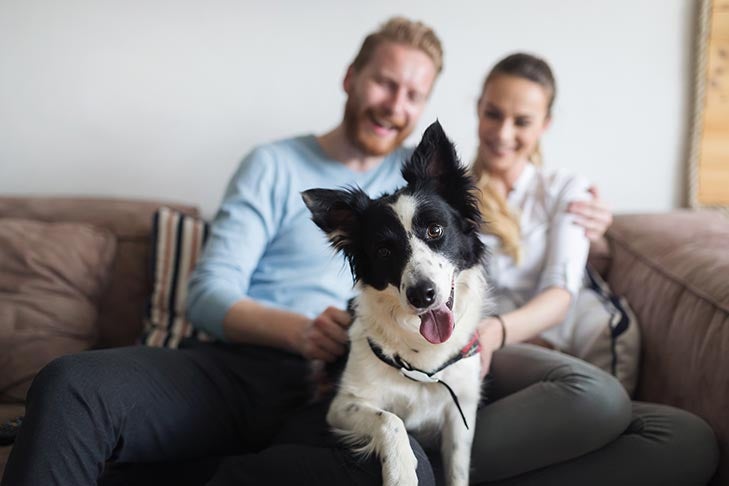After settling into your comfy chair, you’re ready for a movie night at home. Before you can say “Pass the popcorn,” your dog approaches, sits on your feet, and leans on your legs. This gesture has precedent, too; historically, aristocratic ladies used some small breeds as foot warmers. Plenty of doggie cushions line the floor, so why does your pup use you as a canine couch?
Why Dogs Perch on Their People
Dogs sit on their owners’ feet and lean on legs for many reasons. But dogs often perch on their humans because they are displaying or looking for affection, feeling anxious, seeking security, or guarding their owners. Arthritic dogs also might prefer this raised position because they don’t have to bend down to sit.
“Often when dogs sit on our feet, it’s because they want to be close to us,” says Dr. Mary Burch, Ph.D., a certified applied animal behaviorist and director of the AKC’s Family Dog Program. “It’s one way a dog shows affection. Think of your dog sitting on your feet as the canine version of a hug or cuddle.” Puppies and adult dogs of any age, size, sex, or breed choose this place to plop because they want to stay close to their new owners.

Dogs sense human emotions, especially when an owner feels sad or ill. A sit and leg lean comes in handy to add comfort and support. If multiple dogs live together, the competition is on to see who can occupy the space closest to the owner.
When using you as a footrest, dogs might just give you a sly, aren’t-I-adorable expression, too. This bonding attempt usually wins them extra attention through communication and extra petting, including ear rubs. This attention makes them more likely to repeat the act in the future.
Love and Warmth
In cold or damp weather, dogs roost on their owners’ fuzzy slippers and sweatpants to keep toasty. “The dog gets close to your body to stay warmer,” Burch says. “There’s a good chance this move comes from instinctual behavior as puppies.”
If you’ve watched a litter of sleeping puppies, they often huddle together. Not only does this position keep them warm, but it also makes them feel safe. Other dogs want to be as close to their owners as possible and opt to sit on their feet so they can follow them quickly if they move.
Anxiety, Security, and Guarding
New locations or situations may present challenges for anxious or stressed dogs. Remaining close to you gives them added security. If plopping on your toes doesn’t usually happen at home, but your dog suddenly opts for your feet, try to figure out what might be scaring your pup.
Look at your dog’s body language for these signs of fear:
- Drooling
- Shaking
- Panting
- Crouching
- Tail tightly tucked under the body or between the legs
- Head hanging down
- Ears pulled back
Separation anxiety can prompt sitting and seeking reassurance. Also, loud, unfamiliar, or surprising noises like fireworks, thunder, construction sounds, or people arguing can frighten canines. When a dog stays close, they knows their owner has their back. “At a dog park, you may notice a dog sitting on its owner’s feet,” Dr. Burch says. “This protects the owner or signals to other dogs, ‘This is my person.’ ”

If a dog feels anxious or threatened at times, such as visiting the veterinarian’s office, the pup might hug your legs and sink into your feet for comfort and reassurance. “Sarge, my Welsh Springer Spaniel, was a great dog, compliant and well-trained, but walk into the veterinarian’s office for a checkup and the nerves would start,” Dr. Burch remembers. “He would shed, pant, back up, and sit between my legs with his front paws on my feet. Within minutes, the panting would subside. This scene repeated itself at most veterinary visits.”
How do you fix a dog sprawling over someone’s lower limbs and refusing to move? Mention the word “treat,” and suddenly, there’s no problem. In a flash, your dog will be up off your feet.

